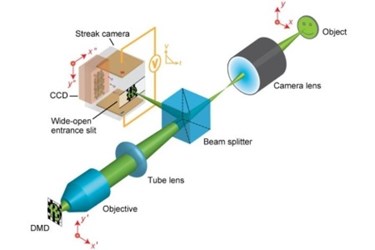Meet The World's Fastest 2D Camera
By Chuck Seegert, Ph.D.

A new advance from Washington University in St. Louis has led to the world’s fastest receive-only 2D camera, which is capable of capturing 100 billion frames per second. New applications in fluorescent biomedicine are now possible, including the actual visualization of light on the fly.
High-speed imaging has now advanced by several orders of magnitude, according to a recent press release from Washington University of St. Louis (WUSL). Current technologies are limited by on-chip storage capacity and electronic readout speed, which means they can achieve about 10 million frames per second at best. The newly developed 2D camera can capture up to 100 billion frames per second — fast enough to capture the motion of light as it travels.
“For the first time, humans can see light pulses on the fly,” said Lihong Wang, Ph.D., the Gene K. Beare Distinguished Professor of Biomedical Engineering at WUSL, in the press release.
The new imaging method, called compressed ultrafast photography (CUP), is similar to traditional photography, which means it is receive-only, according to a recent study published by the research team in Nature. Some other fast imaging methods require special illumination to generate single shots of images. CUP, on the other hand, is capable of recording luminescent objects and can use a variety of different light sources. The technology is based on another technology called the streak camera, but it employs another apparatus called a digital micromirror device (DMD), which includes approximately one million micromirrors.
“Because this technique advances the imaging frame rate by orders of magnitude, we now enter a new regime to open up new visions,” Wang said in the press release. “Each new technique, especially one of a quantum leap forward, is always followed a number of new discoveries. It’s our hope that CUP will enable new discoveries in science — ones that we can’t even anticipate yet.”
Capable of studying time-evolving events that are not repetitive, the CUP camera is capable of resolving events on the tens of picoseconds timescale, according to the study. In addition, the camera can measure an x-y-t scene, where x and y are spatial coordinates and t is time, within a single snapshot. To demonstrate the power of this technique, the WUSL researchers collected images of several fundamental physical phenomena using single laser shots, including laser pulse reflection and refraction, photon racing in two media, and faster-than-light propagation of non-information.
The filming of fluorescent processes by the team has already demonstrated that the CUP technology is suitable for applications in biomedicine, according to the press release. One of Dr. Wang’s research focuses is the deep imaging of biological tissues. The application of high-speed data collection on fluorescent molecules has captured the conversion of green light as it turns to red. This provides a single-shot assessment of fluorescence lifetime, which could be used to detect disease processes.
Advances in fluorescent imaging continue to accumulate. Recently, a dual-function nanoparticle capable of MRI imaging and fluorescent imaging was introduced.
Image Credit: Lihong Wang, Ph.D.
